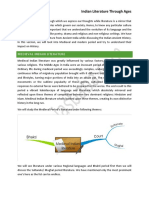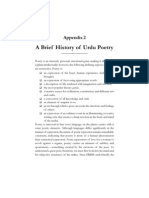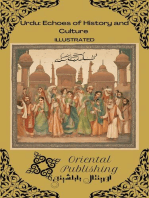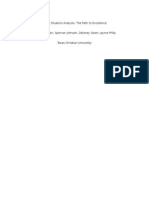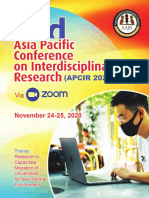0 ratings0% found this document useful (0 votes)
8 viewsIndian Literature-GS Project
Indian Literature-GS Project
Uploaded by
Zeeshan MalikIndian literature encompasses writings produced in many languages across the Indian subcontinent prior to 1947 and within the Republic of India after. Some of the earliest literature is sacred texts like the Rigveda from 1400 BC. Major works include the epic Mahabharata and romance Ramayana. Islamic literature incorporated Arabic and Urdu. Modern literature saw growth of works in languages like Hindi, Gujarati, Marathi, Tamil, and Malayalam from the late 19th century onward, often addressing themes of nationalism, social reform, and modernization.
Copyright:
© All Rights Reserved
Available Formats
Download as DOCX, PDF, TXT or read online from Scribd
Indian Literature-GS Project
Indian Literature-GS Project
Uploaded by
Zeeshan Malik0 ratings0% found this document useful (0 votes)
8 views5 pagesIndian literature encompasses writings produced in many languages across the Indian subcontinent prior to 1947 and within the Republic of India after. Some of the earliest literature is sacred texts like the Rigveda from 1400 BC. Major works include the epic Mahabharata and romance Ramayana. Islamic literature incorporated Arabic and Urdu. Modern literature saw growth of works in languages like Hindi, Gujarati, Marathi, Tamil, and Malayalam from the late 19th century onward, often addressing themes of nationalism, social reform, and modernization.
Copyright
© © All Rights Reserved
Available Formats
DOCX, PDF, TXT or read online from Scribd
Share this document
Did you find this document useful?
Is this content inappropriate?
Indian literature encompasses writings produced in many languages across the Indian subcontinent prior to 1947 and within the Republic of India after. Some of the earliest literature is sacred texts like the Rigveda from 1400 BC. Major works include the epic Mahabharata and romance Ramayana. Islamic literature incorporated Arabic and Urdu. Modern literature saw growth of works in languages like Hindi, Gujarati, Marathi, Tamil, and Malayalam from the late 19th century onward, often addressing themes of nationalism, social reform, and modernization.
Copyright:
© All Rights Reserved
Available Formats
Download as DOCX, PDF, TXT or read online from Scribd
Download as docx, pdf, or txt
0 ratings0% found this document useful (0 votes)
8 views5 pagesIndian Literature-GS Project
Indian Literature-GS Project
Uploaded by
Zeeshan MalikIndian literature encompasses writings produced in many languages across the Indian subcontinent prior to 1947 and within the Republic of India after. Some of the earliest literature is sacred texts like the Rigveda from 1400 BC. Major works include the epic Mahabharata and romance Ramayana. Islamic literature incorporated Arabic and Urdu. Modern literature saw growth of works in languages like Hindi, Gujarati, Marathi, Tamil, and Malayalam from the late 19th century onward, often addressing themes of nationalism, social reform, and modernization.
Copyright:
© All Rights Reserved
Available Formats
Download as DOCX, PDF, TXT or read online from Scribd
Download as docx, pdf, or txt
You are on page 1of 5
Indian Literature & Language
Indian literature, writings of the Indian subcontinent,
produced there in a variety of vernacular languages,
including Sanskrit, Prakrit, Pali, Bengali, Bihari, Gujarati, Hind
i, Kannada, Kashmiri, Malayalam, Oriya, Punjabi, Rajasthani, T
amil, Telugu, Urdu, Lahnda, Siraiki, and Sindhi, among others,
as well as in English. The term Indian literature is used here to
refer to literature produced across the Indian subcontinent
prior to the creation of the Republic of India in 1947 and within
the Republic of India after 1947.
Earliest Indian Literature
The earliest literature is of a sacred character and dates
from about 1400 BC in the form of the Rigveda. Rigveda is
the oldest document in literature of south Asia. This work
stands at the beginning of the literature of the Veda,
or canonical Hindu sacred writings, which as a whole is
roughly contemporary with the settlement of the Indo-
Aryan peoples in the Punjab and farther east, in the
Mesopotamia of the Ganges and Yamuna rivers.
The language of the Rigveda, which is a compilation of
hymns to the high gods of the Aryan religion, is complex
and archaic. It was simplified and codified in the course of
the centuries from 1000 to 500 BC, which saw the
development of prose commentaries called
the Brahmanas, Aranyaka’s, and Upanishads. While
there must have been a long tradition of grammarians, the
final codification of the language is ascribed to Panini (5th
or 6th century BC), whose grammar has remained
normative for the correct language ever since. This
language is called Sanskrit (Tongue Perfected).
Mahabharat
Like most Sanskrit poetry, the Mahabharata consists of
couplets, two successive lines with the same metre.
Generally, one metre is used throughout the poem,
though for stylistic effects other metres may be
interspersed. The epic metre, or shloka, is a very fluid
one that lends itself excellently to improvisation.
The Mahabharata is the longest poem in history, with
about 100,000 couplets, more than seven times the size
of Homer’s Iliad and Odyssey combined. Its characters
go back to around 1000 BC, but in its present form the
epic could not have been composed before 400 BC.
From that time until AD 400, it underwent continuous
elaboration, by insertions of episodes (one of which is
related in the religious poem called the Bhagavad-
Gita), accounts of separate adventures of the heroes,
tales generated by their ancestors, and so on; and in the
end it became a storehouse of general Hindu lore, with
lengthy didactic books inserted.
Ramayana
While the unity of the Mahabharata has been disrupted
by interpolations, the unity of the second epic,
the Ramayana, has been remarkably preserved. It is
less an epic than a romance, recounting the story of
prince Rama and his wife Sita.
Buddhist Texts
The earliest records of Buddhism are not textual but
inscriptional, in the famous edicts of the Mauryan
emperor Ashoka, who reigned c. 269–232 BC. Among
these inscriptions on stone, the so-called 13th rock edict
—in which Ashoka, after the massacre of
the Kalinga’s (modern Orissa), abjures war—is the most
moving document of any dynastic history. The
inscriptions were written in a variety of Prakrit’s; that
is, Indo-Aryan languages closely cognate to, but
considerably later than, the earliest stabilized Sanskrit.
Islamic Literature
Arabic
Arabic was the language of the conquerors of Sind. But
it enjoyed more permanent prestige as the language of
the Qur’an, the sacred book of Islam; as such it was
extensively used for religious scholarship during
the medieval period. Even as late as the 18th
century, Shah Wail Allah, the greatest theologian to
have lived in India, wrote his most
important treatises in Arabic. Arabic was also used early
for historiography and for making Indian scientific
books available to the Middle East in translation. One
does not find, however, much in the way of significant
Arabic belle’s letters in India.
Urdu
Earlier varieties of Urdu, variously known
as Gujari, Hindawi, and Dakhani, show more affinity with
eastern Punjabi and Haryani than with Khari Boli, which
provides the grammatical structure of standard modern
Urdu. The reasons for putting together the literary products
of these dialects, forming a continuous tradition with those
in Urdu, are as follows: first, they share a common milieu,
consisting of Sufi and Muslim court culture, increasingly
dominated by the life and values of the urban elite; second,
they display wholesale acceptance of Perso-Arabic literary
traditions, including genres, metres, and rhetoric; third,
they show an increasing acceptance of Perso-Arabic
grammatical devices and vocabulary; and fourth, they tend
to prefer Perso-Arabic forms over indigenous forms for
learned usage. Urdu literature began to develop in the 16th
century, in and around the courts of the Quṭb Shāhī and
ʿĀdil Shāhī, kings of Golconda and Bajpur in the Deccan
(central India). In the later part of the 17th
century, Aurangabad became the centre of Urdu literary
activities.
Modern Literature Of India
Hindi
Modern Hindi literature began with Harishchandra in
poetry and drama, Mahavir Prasad Dvivedi in criticism and
other prose writings, and Prem Chand in fiction. This
period, the second half of the 19th century, saw mainly
translations from Sanskrit, Bengali, and English. The
growth of nationalism and social reform movements of
the Arya Samaj led to the composition of long narrative
poems, exemplified by those of Maithili Sharan Gupta;
dramas, by those of Jayashankar Prasad; and historical
novels, by those of Prasad, Chatureen Shastri, and
Vrindavan Lal Varma. The novels drew mainly on the
periods of the Maurya, Gupta, and Mughal empires.
Gujrati
In Gujarāt, too, the advent of British rule deeply influenced
the literary scene. The year 1886 saw
the Kusumamālā (“Garland of Flowers”), a collection of
lyrics by Narsingh Rao. Other poets include Kalapi, Kant,
and especially Nanalal, who experimented in free verse and
was the first poet to eulogize Gandhi. Gandhi, himself a
Gujarati, admonished poets to write for the masses and
thus inaugurated a period of poetic concern with changes in
the social order. Many incidents in Gandhi’s life inspired
the songs of poets. The Gandhi period in Gujarāt as
elsewhere gave way to a period of progressivism in the
class-conflict poetry of R.L. Meghani and Bhogilal Gandhi.
In post-independence India, poetry has tended to become
subjectivist and alienated without, however, fully
superseding the traditional verse of devotion to God and
love of nature.
Marathi
The modern period in Marathi poetry began
with Kesavasut and was influenced by 19th-century
British Romanticism and liberalism, European nationalism,
and the greatness of the history of Mahārāshtra. Kesavasut
declared a revolt against traditional Marathi poetry and
started a school, lasting until 1920, that emphasized home
and nature, the glorious past, and pure lyricism. After that,
the period was dominated by a group of poets called
the Ravikiraṇ Maṇ ḍ al, who proclaimed that poetry was not
for the erudite and sensitive but was instead a part of
everyday life. Contemporary poetry, after 1945, seeks to
explore man and his life in all its variety; it is subjective and
personal and tries to speak colloquially.
Tamil
In the second half of the 19th century two tendencies were
present in Tamil literature. One was the old traditional
prose style of the Patiṉeṇ-kīḻkkaṇakku, or
“Eighteen Ethical Works” learned and severely scholastic;
among others, V.V. Svaminatha Iyer and Arumuga Navalar
wrote in this style. Another tendency, begun by Aruṇ ācala
Kavirāyar in the 18th century, sought to bring the spoken
and written languages together. This tendency developed on
one side into such works as the operatic play Nantaṉār
Carittarak Kīrttaṉai by Gopalakrishna, and on the other
into ballads, often based on the lore of the
Sanskrit Purāṇas. Despite attempts to affect a synthesis
between the two languages, however, the scholastic style
has continued to have a profound influence on modern
Tamil literature; the normal spoken language, in fact, never
became a literary medium.
Malayalam
In Malayalam the modern movement began in the late 19th
century with Asan, who was temperamentally a pessimist—
a disposition reinforced by his metaphysics—yet all his life
was active in promoting his downtrodden
Ezhava community. Ullor wrote in the classical tradition, on
the basis of which he appealed for universal love,
while Vallathol (died 1958) responded to the human
significance of social progress.
You might also like
- Pali & Prakrit LanguageDocument8 pagesPali & Prakrit LanguageAtul Bhosekar100% (2)
- Bece English Language Past Questions 2018Document5 pagesBece English Language Past Questions 2018Anonymous lnC6IDg100% (4)
- CHESSDocument3 pagesCHESSJoseph R. Galleno100% (2)
- Indian LiteratureDocument72 pagesIndian LiteratureMaria Kristina EvoraNo ratings yet
- Paper 23 PDFDocument189 pagesPaper 23 PDFSurajit MondalNo ratings yet
- Literature in Persian Sanskrit and RegioDocument12 pagesLiterature in Persian Sanskrit and Regionexusforbusiness7No ratings yet
- Medieval IndiaDocument3 pagesMedieval IndiaharipriyaNo ratings yet
- BengaliDocument5 pagesBengalisukuje0% (1)
- Module Lit 4Document30 pagesModule Lit 4briyvizNo ratings yet
- Chapter 8 Indian LiteratureDocument3 pagesChapter 8 Indian LiteratureAmaresh JhaNo ratings yet
- Overview of Afro-Asian Literature Afro-Asian LiteratureDocument15 pagesOverview of Afro-Asian Literature Afro-Asian LiteratureMILCAH PARAYNONo ratings yet
- Indian Literature - WikipediaDocument106 pagesIndian Literature - WikipediaNaga jyothiNo ratings yet
- Notes On Indian LiteratureDocument3 pagesNotes On Indian LiteraturejadiobiladoNo ratings yet
- Language EvolutionDocument21 pagesLanguage Evolutionadhikari9528No ratings yet
- Indian LiteratureDocument7 pagesIndian LiteratureElizabeth ManiulitNo ratings yet
- Indian Literature CBSE ProjectDocument16 pagesIndian Literature CBSE ProjectZeeshan MalikNo ratings yet
- Literature Through Ages (Freeupscmaterials - Org)Document21 pagesLiterature Through Ages (Freeupscmaterials - Org)SilversterNo ratings yet
- Indian Literature Oral Literary Tradition in IndiaDocument1 pageIndian Literature Oral Literary Tradition in IndiaAnurag UpadhyayNo ratings yet
- History of Medieval India 4Document101 pagesHistory of Medieval India 4Asim MudgalNo ratings yet
- Indian LiteratureDocument15 pagesIndian Literatureabhinav_choudhary03No ratings yet
- Sanskrit, Prakrit and TamilDocument4 pagesSanskrit, Prakrit and Tamilapi-19981632100% (2)
- 2indian LiteratureDocument18 pages2indian LiteratureSahria GuroNo ratings yet
- Muslim Literatures in South Asia The Muslim AlmanacDocument12 pagesMuslim Literatures in South Asia The Muslim AlmanacShahid.Khan1982No ratings yet
- Urdu Literature TrendsDocument5 pagesUrdu Literature TrendsAbu Talha Farooqi100% (1)
- 11 Sohail Sahab 29 1Document11 pages11 Sohail Sahab 29 1merajaeonNo ratings yet
- Medieval Kannada LiteratureDocument5 pagesMedieval Kannada LiteratureShweta NmNo ratings yet
- The Emergence of Hindi LiteratureDocument24 pagesThe Emergence of Hindi LiteratureAshutoshNo ratings yet
- Medieval LiteratureDocument22 pagesMedieval LiteratureKanishka SharmaNo ratings yet
- Indian LiteratureDocument7 pagesIndian LiteraturejimmybarillojrNo ratings yet
- Indian Literature1Document11 pagesIndian Literature1jimmybarillojrNo ratings yet
- Slide Summer 21 Bangla Language and LiteratureDocument66 pagesSlide Summer 21 Bangla Language and LiteratureSadman IslamNo ratings yet
- LDocument13 pagesLAngira KotalNo ratings yet
- Unit 33Document13 pagesUnit 33Anushka NandkeolyarNo ratings yet
- CC-5: HISTORY OF INDIA (CE 750-1206) : V. Religious and Cultural DevelopmentsDocument4 pagesCC-5: HISTORY OF INDIA (CE 750-1206) : V. Religious and Cultural DevelopmentsYaar Jigree Season 3No ratings yet
- History of Urdu PoetryDocument9 pagesHistory of Urdu PoetrygetkakNo ratings yet
- Characteristics of Indian LiteratureDocument2 pagesCharacteristics of Indian Literaturelovely batnagNo ratings yet
- F4 The Growth of New Literary Languages in Medieval IndiaDocument4 pagesF4 The Growth of New Literary Languages in Medieval Indiasanam jainNo ratings yet
- Afro Asia MythDocument18 pagesAfro Asia MythGidz Fernandez Eslabra100% (1)
- Hindu LiteratureDocument4 pagesHindu LiteratureScribdTranslationsNo ratings yet
- The History of Asian LiteratureDocument2 pagesThe History of Asian LiteratureBelle100% (3)
- Hindi Literature PDFDocument2 pagesHindi Literature PDFpiyush KesarwaniNo ratings yet
- MarathiDocument4 pagesMarathiSachin Ketkar100% (1)
- Telugu and BrajDocument2 pagesTelugu and BrajTanvi GuptaNo ratings yet
- Characteristics of Asian LitDocument3 pagesCharacteristics of Asian LitKent Vincent Alburan38% (8)
- Indian LiteratureDocument14 pagesIndian LiteratureMark Anthony DacilloNo ratings yet
- A Brief Survey of Sanskrit PDFDocument8 pagesA Brief Survey of Sanskrit PDFARNAB MAJHINo ratings yet
- Literature of South India in Indian LanguageDocument7 pagesLiterature of South India in Indian Languageranetha vNo ratings yet
- 07 Chapter 2Document54 pages07 Chapter 2Zenith RoyNo ratings yet
- ActivityDocument3 pagesActivityRamyres DavidNo ratings yet
- VisionIAS Value Added Material Important Themes For Medieval History and Art and CultureDocument28 pagesVisionIAS Value Added Material Important Themes For Medieval History and Art and Culturep JangraNo ratings yet
- PersianLitInIndia PDFDocument13 pagesPersianLitInIndia PDFMohammed ArshadNo ratings yet
- African LiteratureDocument2 pagesAfrican LiteraturePeniel Joy BanagaNo ratings yet
- A History of Hindi Literature 1000274525Document126 pagesA History of Hindi Literature 1000274525nirishkumar100% (1)
- INDIADocument10 pagesINDIAGerlyn GaroniaNo ratings yet
- Indian LiteratureDocument18 pagesIndian LiteratureDaryl Jan SalemNo ratings yet
- T.V. Reddy's Fleeting Bubbles: An Indian InterpretationFrom EverandT.V. Reddy's Fleeting Bubbles: An Indian InterpretationNo ratings yet
- Investigatory Project BIODocument6 pagesInvestigatory Project BIOZeeshan MalikNo ratings yet
- Akuvox E18C Datasheet - 20211025 - V1.0Document2 pagesAkuvox E18C Datasheet - 20211025 - V1.0Zeeshan MalikNo ratings yet
- Akuvox X912 Quick Guide - V1.0 TZ-SM-002347Document4 pagesAkuvox X912 Quick Guide - V1.0 TZ-SM-002347Zeeshan MalikNo ratings yet
- Akuvox Catalogue2019Document53 pagesAkuvox Catalogue2019Zeeshan MalikNo ratings yet
- Some Examples of English Words Borrowed From Foreign LangaugesDocument2 pagesSome Examples of English Words Borrowed From Foreign LangaugesKinley WangchukNo ratings yet
- Hotstart In-Block Heater Installation InstructionsDocument1 pageHotstart In-Block Heater Installation Instructionsmohammed barghothiNo ratings yet
- The Sacramental Celebration of The Paschal MysteryDocument19 pagesThe Sacramental Celebration of The Paschal MysteryChrizzle TamponNo ratings yet
- 1-130 Team1 Project1-Doc Overmyer Gil Ringor Combs BosworthDocument36 pages1-130 Team1 Project1-Doc Overmyer Gil Ringor Combs Bosworthapi-655484178No ratings yet
- Group Assignment III 12032019Document11 pagesGroup Assignment III 12032019MaiiNo ratings yet
- SKODA ASN-ig enDocument14 pagesSKODA ASN-ig enqingpingleNo ratings yet
- Decide To Commit It.": Case of People of The R.P. vs. Pugay No. L-74324 17november1988Document2 pagesDecide To Commit It.": Case of People of The R.P. vs. Pugay No. L-74324 17november1988Ashley Kate PatalinjugNo ratings yet
- (The Library of New Testament Studies 89) Craig A. Evans - Word and Glory - On The Exegetical and Theological Background of John's Prologue-Bloomsbury T&T Clark (1993)Document250 pages(The Library of New Testament Studies 89) Craig A. Evans - Word and Glory - On The Exegetical and Theological Background of John's Prologue-Bloomsbury T&T Clark (1993)Nelson100% (5)
- Learning Plan: Analogy To Show Relationships of WordsDocument2 pagesLearning Plan: Analogy To Show Relationships of WordsMonaliza PawilanNo ratings yet
- Everything You Need To Know About The Conjugation of "Essere" in ItalianDocument1 pageEverything You Need To Know About The Conjugation of "Essere" in ItalianTatjana MilosavljevicNo ratings yet
- How Far Is 7.5 On The Beep Test in KM - Google SearchDocument2 pagesHow Far Is 7.5 On The Beep Test in KM - Google SearchRakhmat Ari WibowoNo ratings yet
- CBRN TeamDocument30 pagesCBRN TeamDinesh YadavNo ratings yet
- Resume GCDocument2 pagesResume GCapi-356177406No ratings yet
- Lindt Phases 1 and 2Document30 pagesLindt Phases 1 and 2api-24727320550% (2)
- CANTILEVER - User and Maintenance ManualDocument10 pagesCANTILEVER - User and Maintenance ManualRaulNo ratings yet
- Exemptions of Article 3 of The Civil Code of The PhilippinesDocument2 pagesExemptions of Article 3 of The Civil Code of The PhilippinesMona LizaNo ratings yet
- Invoice Creation On GeMDocument9 pagesInvoice Creation On GeMhisab bNo ratings yet
- SIEMENS Analysis of Financial StatementDocument16 pagesSIEMENS Analysis of Financial StatementNeelofar Saeed100% (1)
- Ceragon - RF Units PDFDocument3 pagesCeragon - RF Units PDFbaskoroboNo ratings yet
- Lok Sewa AayogDocument5 pagesLok Sewa AayogLokraj SharmaNo ratings yet
- Food Lab 1Document13 pagesFood Lab 1Nurul Syaheerah100% (1)
- Capstone Proposal Final Like Medj FinalDocument22 pagesCapstone Proposal Final Like Medj FinalCABABAN, SHAIRA A. STEM2No ratings yet
- Travel Tips - Kathmandu NepalDocument6 pagesTravel Tips - Kathmandu NepalJenny QiNo ratings yet
- Lesson Plan Budgeting 2 2Document2 pagesLesson Plan Budgeting 2 2Alexander QuemadaNo ratings yet
- AAIR BOA - Complete File - November 23Document54 pagesAAIR BOA - Complete File - November 23Rex LimNo ratings yet
- 1 27Document54 pages1 27MD Omar FarukNo ratings yet
- ACTIVITES in Module 2Document8 pagesACTIVITES in Module 2Jessica CrisostomoNo ratings yet
- The Ontarion - February 4 2010Document23 pagesThe Ontarion - February 4 2010The OntarionNo ratings yet


















